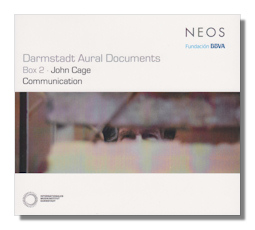
The Internet's Premier Classical Music Source
Related Links
-
Cage Reviews
Wolff Reviews - Latest Reviews
- More Reviews
-
By Composer
-
Collections
DVD & Blu-ray
Books
Concert Reviews
Articles/Interviews
Software
Audio
Search Amazon
Recommended Links
Site News
 CD Review
CD Review
Darmstadt Aural Documents Box 2

- John Cage:
- Third part of the Darmstadt Lecture -
- "Composition as Process" (1958) 1
- Communication 1 1
- Communication 2 1
- Communication 3 1
- Communication 4 1
- Communication 5 1
- Communication 6 1
- Variations I 1,2,3
- Christian Wolff: Piano with Preparations 2
- Bo Nilsson:
- Quantitäten 2
- Quantitäten [bis] 2
1 John Cage, voice
2 David Tudor, piano
3 David Tudor, radio sets
Neos 11213
This CD presents an audio "record" of the third part of John Cage's lecture at the iconic Darmstadt Summer School in 1958, "Composition as Process". It starts with Cage speaking as persuasively as we are used to – but semi-rhetorically (often using questions) as we are less used – about sound, silence, composition and the physics thereof set in the cultural, social, mystical and personal contexts where Cage believes music exists. In the course of this commentary, Cage introduces the music of Nilsson (Quantitäten in two performances [tr.s 5, 7]) and Wolff (Piano with Preparations [tr.3]) as well as Communication 1 to 6 and Variations I of his own.
This arrangement makes excellent listening and and informative experience: the music itself is heard undiluted in performances by Cage and David Tudor. Yet it's nicely set in the context of Cage's exegesis on a rich spectrum of compositional techniques, issues, problems and threads. Although Cage's delivery is surely both extempore, and scripted, it's also faltering and most noticeably frenetic as ideas seem to tumble over themselves in order to lead to a point or series of points (about the nature of the North American avant garde in the 1950s as opposed to the European one) in ways akin to Cage's beloved James Joyce's monologues. That could perhaps be tedious if it were uninterrupted. It's not. Although the long pauses are slightly off-putting. For the time (when analog tape was the recording medium) the acoustic, production and transitions between speech and music have been executed very well by Neos. The engineers at the Schloss Heiligenberg, rather than Darmstadt itself that year, are to be credited for presenting both a historical document (as the CD's title suggests) as an "event" (1958 was the first time that Cage attended Darmstadt). And at the same time a musically rich experience in its own right.
The music, which is miniature, intense, mostly slow, inward looking, and yet which flares of self-assured expression, does benefit from the commentary that Cage provides. None of the six Communication pieces lasts more than seven minutes or so. Neither these nor the Wolff and Nilsson works are otherwise available on CD (although Variations I is). This recording was a world première – as was that of the Nilsson piece. This (discographical) fact makes this CD an attractive one for new music lovers over and above the situating and glosses provided by Cage's "lecture". What's more, the presence of the audience adds a layer of interest to the recordings: one is at an important moment in the history of new music – or at least at an important time for it. Their responses to the humor in Variations I are gentle and genuine and do much to demolish the shibboleth that Cage took himself too seriously.
The text of the start of Cage's lecture, which was not recorded, is reproduced in the informative booklet that comes with the hour long CD. As said, the third in a series – the other two given earlier in the week were on Changes and Indeterminacy during the compositional process; they have not survived. The order, number and duration of the questions to which Cage was replying (translated from German for Cage) was determined by Chance Operations. This adds to the integrity and sense of the occasion. The booklet also contains background on Cage, Tudor and the event as an event: Cage didn't return to Darmstadt until two years before his death, in 1990. It details the notational and "preparation" of the music and instrument(s) too. Significantly, these lectures and the music which Cage used to illustrate his theses on sound and its context, provided stimuli to other musicians and composers at Darmstadt which still resonates.
So, although some will buy and enjoy this CD for the piano music on it alone, it is likely to yield much more when the strengths thereof are set against the compositional explanations and annotations which Cage provides throughout. The acoustic and reproduction are remarkably clear for recordings which are now nearly 45 years old. The performances are spontaneous, lively, considered yet fresh and well-projected for all their self-awareness. Anyone with an interest in moments of change and "departure" in modern music should consider this CD. Cage specialists will want it in any case. It is recommended.
Copyright © 2012, Mark Sealey





















